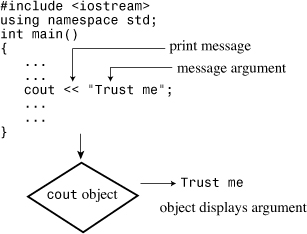cin and cout: A Touch of Class
You’ve seen enough of cin and cout to justify your exposure to a little object lore. In particular, in this section you’ll learn more about the notion of classes. As Chapter 1 outlined briefly, classes are one of the core concepts for object-oriented programming (OOP) in C++.
A class is a data type the user defines. To define a class, you describe what sort of information it can represent and what sort of actions you can perform with that data. A class bears the same relationship to an object that a type does to a variable. That is, a class definition describes a data form and how it can be used, whereas an object is an entity created according to the data form specification. Or, in noncomputer terms, if a class is analogous to a category such as famous actors, then an object is analogous to a particular example of that category, such as Kermit the Frog. To extend the analogy, a class representation of actors would include definitions of possible actions relating to the class, such as Reading for a Part, Expressing Sorrow, Projecting Menace, Accepting an Award, and the like. If you’ve been exposed to different OOP terminology, it might help to know that the C++ class corresponds to what some languages term an object type, and the C++ object corresponds to an object instance or instance variable.
Now let’s get a little more specific. Recall the following declaration of a variable:
int carrots;
This creates a particular variable (carrots) that has the properties of the int type. That is, carrots can store an integer and can be used in particular ways—for addition and subtraction, for example. Now consider cout. It is an object created to have the properties of the ostream class. The ostream class definition (another inhabitant of the iostream file) describes the sort of data an ostream object represents and the operations you can perform with and to it, such as inserting a number or string into an output stream. Similarly, cin is an object created with the properties of the istream class, also defined in iostream.
The class describes all the properties of a data type, including actions that can be performed with it, and an object is an entity created according to that description.
You have learned that classes are user-defined types, but as a user, you certainly didn’t design the ostream and istream classes. Just as functions can come in function libraries, classes can come in class libraries. That’s the case for the ostream and istream classes. Technically, they are not built in to the C++ language; instead, they are examples of classes that the language standard specifies. The class definitions are laid out in the iostream file and are not built into the compiler. You can even modify these class definitions if you like, although that’s not a good idea. (More precisely, it is a truly dreadful idea.) The iostream family of classes and the related fstream (or file I/O) family are the only sets of class definitions that came with all early implementations of C++. However, the ANSI/ISO C++ committee added a few more class libraries to the Standard. Also most implementations provide additional class definitions as part of the package. Indeed, much of the current appeal of C++ is the existence of extensive and useful class libraries that support Unix, Macintosh, and Windows programming.
The class description specifies all the operations that can be performed on objects of that class. To perform such an allowed action on a particular object, you send a message to the object. For example, if you want the cout object to display a string, you send it a message that says, in effect, “Object! Display this!” C++ provides a couple ways to send messages. One way, using a class method, is essentially a function call like the ones you’ll see soon. The other way, which is the one used with cin and cout, is to redefine an operator. Thus, the following statement uses the redefined << operator to send the “display message” to cout:
cout << "I am not a crook."
In this case, the message comes with an argument, which is the string to be displayed. (See Figure 2.5 for a similar example.)
Figure 2.5. Sending a message to an object.

Functions
Because functions are the modules from which C++ programs are built and because they are essential to C++ OOP definitions, you should become thoroughly familiar with them. Some aspects of functions are advanced topics, so the main discussion of functions comes later, in Chapter 7, “Functions: C++’s Programming Modules,” and Chapter 8, “Adventures in Functions.” However, if we deal now with some basic characteristics of functions, you’ll be more at ease and more practiced with functions later. The rest of this chapter introduces you to these function basics.
C++ functions come in two varieties: those with return values and those without them. You can find examples of each kind in the standard C++ library of functions, and you can create your own functions of each type. Let’s look at a library function that has a return value and then examine how you can write your own simple functions.
